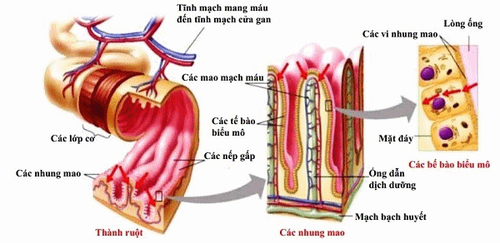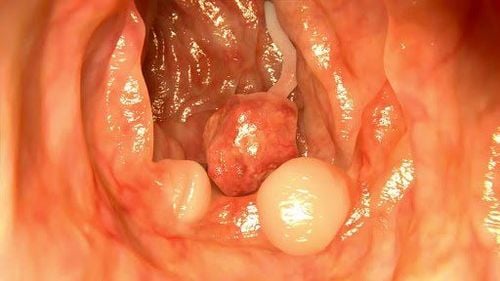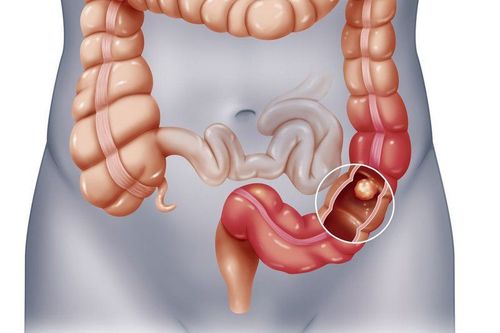This is an automatically translated article.
This article was written by Dr. Mai Vien Phuong - Gastrointestinal Endoscopy - Department of Medical Examination & Internal Medicine - Vinmec Central Park International General Hospital.The small intestine is where the body's main digestion and absorption of food occurs. In the human body, the small intestine is located behind the stomach and before the large intestine (also called the colon). In adults, the length of this part ranges from 5-9m, about 1.5-3cm wide.
1. Structure of the small intestine
The small intestine is an organ of the digestive system, extending from the pylorus of the stomach to the ileocecal valve. The small intestine consists of three parts: duodenum, jejunum, ileum1.1 Duodenum The duodenum is the first part of the small intestine, shaped like a C, extending from the stomach pylorus to the duodenum junction. It is divided into four segments: top, down, bottom and up.
The duodenum receives bile from the gallbladder and digestive enzymes from the pancreas through the "major papilla". This is where most of the digestion of food occurs.
1.2 The jejunum, the ileum The jejunum is the continuation of the small intestine, it extends from the duodenojejunal angle to the ileum. The boundary of the jejunum and ileum is not clear and difficult to define. The last part of the small intestine is the ileum, which connects to the colon through the ileocecal valve. Nutrient absorption takes place mainly in these two parts of the small intestine. The structure of the small intestine is similar to the general structure of the digestive tract wall, consisting of 4 layers: the sheath, the muscular layer, the submucosa, and the mucosa.

2. Learn about small bowel tumors
2.1 Causes of small bowel tumors The cause of small bowel malignancies is unknown. However, there are several risk factors for the disease such as: Crohn's disease, familial mycosis, celiac disease, people who have had their gallbladder removed, smoke a lot, drink a lot of alcohol, eat a lot of red meat.
2.2 Common Small Intestinal Tumors There are two common types of small bowel tumors, benign and malignant.
Benign tumors: accounted for 25%, including: lipomas, intestinal polyps. Malignant neoplasm: adenocarcinoma in duodenum and jejunum; intestinal lymphoma; sarcoma; Gastrointestinal tumors (a type of cancer that can arise elsewhere in the stomach or colon). 2.2.1 Benign Tumors Benign adenomas account for 25% of all benign tumors of the intestine. Benign tumors often have no obvious symptoms and are discovered incidentally during surgery. Benign tumors are usually treated with surgical resection.
Lipoma most commonly occurs in the ileum; Presenting symptoms are usually intestinal obstruction due to intussusception, leiomyomas are often associated with hemorrhage and also cause intussusception, hemangiomas have the same effect as other small bowel tumors but tend to bleed more. Gastrointestinal polyposis is a mild disease. Malignant changes have been reported rarely 2.2.2 Malignancies The treatment of malignancies and their complications is usually surgery.
Adenocarcinoma is the most common cancer of the small intestine, occurring most often in the duodenum and jejunum. Symptoms are due to obstruction or bleeding. Bad prognosis. Lymphomas: Malignant primary small bowel lymphomas are localized lesions mainly in the small intestine and initially without peripheral lymphadenopathy; The onset of clinical symptoms is related to damage to the gastrointestinal tract. The cause of the disease is still not completely known, there are a number of factors that are considered risk factors such as: Crohn's disease, diffuse hypertrophy of small intestine lymphoma, hypogammaglobulinemia, immunodeficiency syndrome acquired translation. Sarcoma most commonly occurs in the mid-small intestine, and may first present as tumor, obstruction, and hemorrhage. The prognosis is conservative. Carcinoid tumors occur most commonly in the gastrointestinal tract or lungs and can arise in other sites including the stomach, colon, bronchi, pancreas, and ovaries. Carcinoid syndrome occurs only with metastatic malignancies. U can secrete serotonin and bradykinin. Systemic manifestations may include: Irritation of flushing and other vasomotor symptoms, dyspnea and wheezing, recurrent episodes of abdominal pain and diarrhea.

2.4 Diagnostic Procedures The diagnosis is quite difficult because, most benign tumors have no symptoms. Only about 20-50% are diagnosed before surgery.
If it is a malignant tumor, a good contrast-enhanced small-bowel scan can show the tumor in 50-70%. Upper-down flexible endoscopy can show a tumor in the duodenum, while an anus-up endoscopy can reveal a tumor in the ileum.
Today, with the help of capsule endoscopy, which transmits images out through a small camera, it helps to show the small intestine lesions quite well.
Abdominal X-ray can show intestinal obstruction but cannot identify small bowel tumor. Mesenteric angiography (DSA or MSCT-64) can indirectly show tumors because many blood vessels are concentrated in one area. CT scan of the abdomen can show leiomyomas as they grow outside the intestinal lumen. 2.5 Treatment of small bowel tumors Treatment of small bowel tumors is the resection of the bowel with the tumor. For benign tumors, extensive resection is the definitive treatment, rarely recurrence, but for malignant tumors, it is difficult to perform radical surgery including regional lymphadenectomy and Whipple surgery in duodenal malignancies.
With malignancies, adjuvant therapy such as combined radio-chemotherapy is effective only for lymphomas; Malignant neoplasms, leiomyomas are resistant to classical chemotherapy. For carcinoid tumors, in addition to resection, lymph node dissection can also be treated with somatostatin or interferon alpha and chemotherapy. With such multimodal treatment, carcinoid tumors have a better outcome than all small bowel malignancies.
Vinmec International General Hospital with a system of modern facilities, medical equipment and a team of experts and doctors with many years of experience in neurological examination and treatment, patients can completely peace of mind for examination and treatment at the Hospital.
For detailed information, please contact the hospitals and clinics of Vinmec health system nationwide.
Please dial HOTLINE for more information or register for an appointment HERE. Download MyVinmec app to make appointments faster and to manage your bookings easily.














